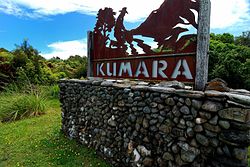
Kumara, New Zealand

Kumara | |
|---|---|
 Sign beside SH 73 on the outskirts of Kumara | |
 | |
| Coordinates: 42°37′52″S 171°11′13″E / 42.63111°S 171.18694°E | |
| Country | New Zealand |
| Region | West Coast |
| District | Westland District |
| Ward | Northern |
| Electorates | |
| Government | |
| • Territorial authority | Westland District Council |
| • Regional council | West Coast Regional Council |
| • Mayor of Westland | Helen Lash |
| • West Coast-Tasman MP | Maureen Pugh |
| • Te Tai Tonga MP | Tākuta Ferris |
| Area | |
| • Total | 2.69 km2 (1.04 sq mi) |
| Population (June 2024)[2] | |
| • Total | 310 |
| • Density | 120/km2 (300/sq mi) |
| Time zone | UTC+12 (NZST) |
| • Summer (DST) | UTC+13 (NZDT) |
| Postcode | 7832 |
| Area code | 03 |
| Local iwi | Ngāi Tahu |
Kumara is a town on the West Coast of the South Island of New Zealand. It is located 30 kilometres (19 mi) south of Greymouth, close to the western end of State Highway 73, which leads across Arthur's Pass to Christchurch. The Taramakau River flows past to the north.[3][4]

The population was 285 in the 2018 census, a decrease of 24 (7.76%) from 2013.

The name may come from the Māori language Kohe mara, which is the blossom of the tātarāmoa, or bush lawyer.[5]

The Coast to Coast annual multisport race starts at Kumara Beach.[6]

History
Kumara was founded and became one of the country's chief gold mining centres following the discovery of gold at Dillmanstown, about 3 kilometres (2 mi) to the south-east, in 1876. The tramline from Greymouth to Paroa was extended to Kumara the following year. The population was 4,220 in October 1877. The town became a borough in 1877.[5] Kumara Hospital was operating by 1881[7] and continued into the twentieth century.[8] In 1882, the Kumara volunteer fire brigade was formed.[9]

Kumara was the home town of prominent politician Richard Seddon, who was elected mayor of the town in 1877,[10] and served as Prime Minister of New Zealand from 1893 until his death in 1906.

In 1925, the manager of Pearns Hotel in Kumara was charged by police after she refused to supply accommodation to two visiting temperance lecturers.[11] The Pearn's Brewery became part of Westland Ales around this time.[12]

Although the town once had 50 pubs, the numbers dwindled. In June 2009, the last remaining pub, the Empire Hotel, had its licence cancelled by the Liquor Licensing Authority.[13] In 2010, the last store of the town faced closure, with only a few hundred inhabitants left, but it was hoped that one of the New Zealand Cycle Trails to run through the town would lift the settlement's fortunes again.[14] In November 2012 the Theatre Royal Hotel reopened as the only pub serving Kumara, and in November 2013 the West Coast Wilderness Trail cycleway running from Greymouth to Ross was officially opened with a ceremony in Kumara.[15]

Demographics
Kumara is described by Statistics New Zealand as a rural settlement and covers 2.69 km2 (1.04 sq mi).[1] It had an estimated population of 310 as of June 2024,[2] with a population density of 115 people per km2. The settlement is part of the larger Arahura-Kumara statistical area.[16]

| Year | Pop. | ±% p.a. |
|---|---|---|
| 2006 | 315 | — |
| 2013 | 309 | −0.27% |
| 2018 | 285 | −1.60% |
| Source: [17] | ||
Kumara had a population of 285 at the 2018 New Zealand census, a decrease of 24 people (−7.8%) since the 2013 census, and a decrease of 30 people (−9.5%) since the 2006 census. There were 135 households, comprising 141 males and 141 females, giving a sex ratio of 1.0 males per female. The median age was 52.2 years (compared with 37.4 years nationally), with 39 people (13.7%) aged under 15 years, 30 (10.5%) aged 15 to 29, 162 (56.8%) aged 30 to 64, and 57 (20.0%) aged 65 or older.

Ethnicities were 92.6% European/Pākehā, 11.6% Māori, 2.1% Pasifika, 3.2% Asian, and 3.2% other ethnicities. People may identify with more than one ethnicity.

Although some people chose not to answer the census's question about religious affiliation, 52.6% had no religion, 31.6% were Christian and 1.1% had other religions.

Of those at least 15 years old, 24 (9.8%) people had a bachelor's or higher degree, and 72 (29.3%) people had no formal qualifications. The median income was $22,700, compared with $31,800 nationally. 27 people (11.0%) earned over $70,000 compared to 17.2% nationally. The employment status of those at least 15 was that 102 (41.5%) people were employed full-time, 42 (17.1%) were part-time, and 9 (3.7%) were unemployed.[17]

Arahura-Kumara statistical area
Arahura-Kumara covers 264.41 km2 (102.09 sq mi)[1] and had an estimated population of 1,490 as of June 2024,[18] with a population density of 5.6 people per km2.

| Year | Pop. | ±% p.a. |
|---|---|---|
| 2006 | 954 | — |
| 2013 | 1,167 | +2.92% |
| 2018 | 1,233 | +1.11% |
| Source: [19] | ||
Before the 2023 census, Arahura-Kumara had a smaller boundary, covering 262.27 km2 (101.26 sq mi).[1] Using that boundary, Arahura-Kumara had a population of 1,233 at the 2018 New Zealand census, an increase of 66 people (5.7%) since the 2013 census, and an increase of 279 people (29.2%) since the 2006 census. There were 522 households, comprising 639 males and 591 females, giving a sex ratio of 1.08 males per female. The median age was 49.8 years (compared with 37.4 years nationally), with 183 people (14.8%) aged under 15 years, 132 (10.7%) aged 15 to 29, 705 (57.2%) aged 30 to 64, and 210 (17.0%) aged 65 or older.

Ethnicities were 89.1% European/Pākehā, 13.6% Māori, 1.0% Pasifika, 3.2% Asian, and 3.4% other ethnicities. People may identify with more than one ethnicity.

The percentage of people born overseas was 12.4, compared with 27.1% nationally.

Although some people chose not to answer the census's question about religious affiliation, 49.9% had no religion, 37.2% were Christian, 0.2% had Māori religious beliefs, 0.5% were Hindu, 0.2% were Muslim and 1.7% had other religions.

Of those at least 15 years old, 147 (14.0%) people had a bachelor's or higher degree, and 249 (23.7%) people had no formal qualifications. The median income was $31,000, compared with $31,800 nationally. 174 people (16.6%) earned over $70,000 compared to 17.2% nationally. The employment status of those at least 15 was that 546 (52.0%) people were employed full-time, 171 (16.3%) were part-time, and 24 (2.3%) were unemployed.[19]

Former swimming pool

In 1934, a community swimming pool was constructed using voluntary labour. The pool was built during the 1930s depression when mining activity and the population of the area had both declined. It was 50 yards (46 m) long and 33 yards (30 m) wide, with a depth of 6.5 feet (2.0 m) at the deep end. The pool was built in the unique surroundings of debris left behind from old gold diggings, with the walls made from boulders from the diggings. Water for the pool was conveyed 3 kilometres (1.9 mi) from the Dillmanstown Kapitea Reservoir using old iron pipes recovered from historic sluicing schemes. The pool was originally part of a sports complex for the township including a basketball court and a cricket pitch. The pool is no longer in use but the area has been registered with Heritage New Zealand as a Category 2 listed place.[20] [21]

Notable buildings
- Notable buildings
-
Bank of New Zealand, Kumara (2021)
-
Theatre Royal Hotel
-
St Patrick's Catholic Church, Kumara (2021)
-
Kumara School
Bank of New Zealand
The Bank of New Zealand was first established in Kumara in 1876.

St Patrick's Catholic Church
St Patrick's was built by the parishioners in 1877.

Education
Kumara School is a coeducational full primary school (years 1–8), with a roll of 31 as of August 2024.[22][23] The school celebrated 120 years of education in the district in 1997.[24]

References
![]() Media related to Kumara, New Zealand at Wikimedia Commons
Media related to Kumara, New Zealand at Wikimedia Commons

- ^ a b c d "ArcGIS Web Application". statsnz.maps.arcgis.com. Retrieved 7 August 2023.
- ^ a b "Aotearoa Data Explorer". Statistics New Zealand. Retrieved 26 October 2024.
- ^ Peter Dowling, ed. (2004). Reed New Zealand Atlas. Reed Books. map 69. ISBN 0-7900-0952-8.
- ^ Roger Smith, GeographX (2005). The Geographic Atlas of New Zealand. Robbie Burton. map 156. ISBN 1-877333-20-4.
- ^ a b Dollimore, Edward Stewart. - "Kumara, Westland". - Encyclopedia of New Zealand (1966).
- ^ "Race profile: Speight's Coast to Coast". Coast to Coast. 2014. Archived from the original on 13 January 2015. Retrieved 13 January 2015.
- ^ "Kumara Hospital". West Coast Times. 6 August 1881. p. 2.
- ^ Rogers, Anna (2005). Illustrated History of the West Coast. Auckland: Reed Books. p. 113. ISBN 0-7900-1022-4.
- ^ Rogers, p. 115.
- ^ Rogers, pp. 71–72.
- ^ Brien, Bill. "Tales from the Past - a look at the history of HANZ". Retrieved 13 August 2008.
- ^ Rogers, p. 160.
- ^ "Residents angry after town's only pub shut down". The New Zealand Herald. 11 June 2009.
- ^ "Hope rests on cycleway". The Press. 18 March 2010. Retrieved 31 March 2010.
- ^ "West Coast welcomes cyclists". The Press. 18 November 2013. Retrieved 13 January 2015.
- ^ 2018 Census place summary: Arahura-Kumara
- ^ a b "Statistical area 1 dataset for 2018 Census". Statistics New Zealand. March 2020. 7023767.
- ^ "Aotearoa Data Explorer". Statistics New Zealand. Retrieved 26 October 2024.
- ^ a b "Statistical area 1 dataset for 2018 Census". Statistics New Zealand. March 2020. Arahura-Kumara (311400). 2018 Census place summary: Arahura-Kumara
- ^ "Kumara Swimming Pool (former)". New Zealand Heritage List/Rārangi Kōrero. Heritage New Zealand.
- ^ "Kumara Baths". Christchurch Star. 18 December 1934 – via Papers Past.
- ^ "New Zealand Schools Directory". New Zealand Ministry of Education. Retrieved 17 September 2024.
- ^ Education Counts: Kumara School
- ^ "Jubilees & reunions: Goldfields Schools". Education Gazette New Zealand. 76 (9). 26 May 1997. [permanent dead link]
See what we do next...
OR
By submitting your email or phone number, you're giving mschf permission to send you email and/or recurring marketing texts. Data rates may apply. Text stop to cancel, help for help.
Success: You're subscribed now !




